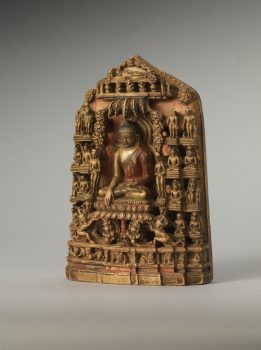Northeastern India
12th century
This is the gesture of the Buddha calling the earth to witness his awakening.
Northeastern India
12th century



The northeastern Indian village of Bodhgaya, the place of the Buddha’s enlightenment, was and continues to be an important pilgrimage site. While in Bodhgaya some pilgrims picked up small souvenir sculptures dedicated to the Buddha’s life, and this small portable stone relief carving is an example of such and object. The image of the Buddha at the center of the stele shows him seated under a tree with his right hand touching the earth, a common visual reference to the moment of his enlightenment. This figure and the six buddhas at its sides represent the seven weeks the Buddha spent meditating in Bodhgaya. The scenes on the stele’s periphery depict events from the Buddha’s life, culminating at the top with his achievement of nirvana at death.The physical appearance of the Buddha, featuring a disproportionally short and thick neck, is a direct reference to the main image that occupied the temple at Bodhgaya from about the eleventh to the thirteenth century, when after waves of foreign invasions Buddhism declined in India and Bodhgaya seems to have become defunct as a pilgrimage site, thereby ceasing to be a cultural conduit for Tibetans for whom these images were important.
A state of “waking up” from illusion and seeing the true nature of reality. Buddha Shakyamuni attained enlightenment while meditating under the bodhi tree. Buddhist teaching explains that the accumulation of merit and wisdom are essential for achieving enlightenment, also known as awakening.
A vehicle for the preservation and transmission of knowledge. The Buddha’s teachings were originally passed down through oral transmission and storytelling, and stories of the Buddha’s past lives are considered an important source of inspiration and guidance.
A state of “waking up” from illusion and seeing the true nature of reality. Buddha Shakyamuni attained awakening while meditating under the bodhi tree. Buddhist teaching explains that the accumulation of merit and wisdom are essential for achieving awakening, also known as enlightenment.
An awakened being who understands the true nature of reality and is free from the cycle of birth, death, and rebirth. While there are many buddhas, Siddhartha Gautama is the historical Buddha, whose teachings became the foundation of Buddhism.
As the cradle of Buddhism, northeastern India was and remains today a region abundant in sacred Buddhist sites. Through the late 13th century, India was the epicenter for the production of Buddhist material and visual culture, with teachers, monks, traders, and pilgrims bringing objects back home to Tibet, western Himalayan regions, Nepal, and beyond.
Get the latest news and stories from the Rubin, plus occasional information on how to support our work.